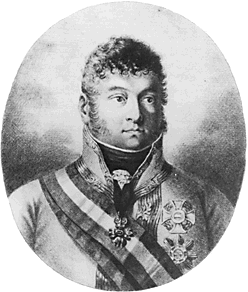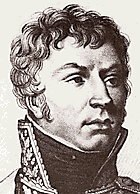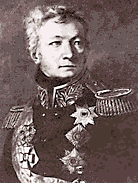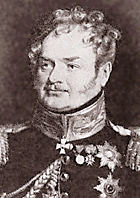The Austrian Forces
 FM
Furst Schwarzenberg (shown at left)
FM
Furst Schwarzenberg (shown at left)
Commander in Chief
 DIVISION BIANCHI
DIVISION BIANCHI
Brigade Hesse Homberg
Infantry Regiment Nr. 2, Hiller (2 Btns.)
Infantry Regiment Nr. 33, Colloredo-Mansfeld (2 Btns.)
Hungarian Grenadier Batt. Kirchenbetter (I.R. 34,37,60)
Brigade Lilienberg
Infantry Regiment Nr. l9, Alvinczy (2 Btns.)
Infantry Regiment Nr. 48, Vukassovich (2 Btns.)
German Grenadier Batt. Brezezinsky (I.R. 30,41,58)
DIVISION SIEGENTHAL
Brigade Mohr
Infantry Regiment Nr.9, Czartoryski (2 Btns.)
Infantry Regiment Nr. 30, Prinz de Ligne (2 Btns.)
Brigade Lichtenstein
Infantry Regiment Nr. l6, Lusignan
Infantry Regiment Nr. 34, Furst A. Esterhazy
Infantry Regiment Nr. 41, Kottulinski (2 Btns.)
Brigade Bolza
Jaeger Batt. Nr. 7.
Plus either I.R. Lusignan or I.R. Esterhazy listed under Brigade
Lichtenstein
DIVISION TRAUTENBERG
Brigade Meyer
Infantry Regiment Nr.7, FML Baron Schroder
Infantry Regiment Nr. 39, Baron Duka
Brigade Pflacher
Grenz Infantry Regiment Nr. 6, St. Georger (2 Btns.)
Jaeger Batt. Nr. 5 (1 Btn.)
DIVISION FRIMONT
Brigade Schmelzer
*Dragoon Regiment Nr. 1, Erzherzog Johann (6 Sqns.)
Chevauleger Regiment Nr. 3, O'Reilly (6 Sqns.)
Chevauleger Regiment Nr. 2, Hohenzollern-Hechingen (6 Sqns.)
Brigade Frolich
Dragoon Regiment Nr. 6, Reisch
Hussar Regiment Nr. 4, Hessen-Homburg (8 Sqns.)
Brigade Zechmeister
Hussar Regiment Nr. 6, Blankenstein (8 Sqns.)
Hussar Regiment Nr. 8, Kienmayer
ARTILLERY
Foot Artillery, 4 batteries
Horse Artillery, 2 batteries
(A total of some 60 guns)
Plus the usual engineering and pioneer support units
* Detached to the reserve forces in Galicia.
Also in Galicia:
Staff-Dragoon Division No. 1
Formed in 1812 and commanded by major Albert Haeneke. Served with the reserve
Corps in Galicia. In 1813-15 it served with the main army at Leipzig, through
Gemany and into France. Dissolved in Galicia in 1816.
Note that the various authorities differ in the composition of the brigades and
divisions. Partly this is due to divisions, brigades and regiments being named
after their "current" commander. When the commander changed so did the unit name.
For this reason I try to also list the unit "number" which did not change. But
some lists place units as present that others do not confirm, as with the Warasdiner
Grenz being possibly with Brigade Bolza, and some not confirming my listing of
Dragoon Rgt. Nr. 6 while claiming that Hussar Reg. 1, Kaiser was attached to Brigade
Frolich. I am continually working to resolve these discrepancies.
The 7th (Saxon) Corps of the Grande Armée
 C-in-C General de Division Reynier
(shown at left)
C-in-C General de Division Reynier
(shown at left)
Chief of Staff: Goure, Adjutant Commandant
21st DIVISION.
General Lieutenant Lecoq
Brigade: Generalmajor von Stiendel
Libenau Grenadier Battalion (1 Btn.)
Prinz Frederick Infantry Regimen (2 Btns.)
Prinz Clemens Infantry Regiment (2 Btns.)
Brigade: Generalmajor von Nostitz
1st Light Infantry Regiment (2 Btns.)
Prinz Anton Infantry Regiment (2 Btns.)
Artillery: Major von Grossman
4th Foot Battery "Rouvroy" (6 pounders)
22nd DIVISION:
General Lieutenant von Funck (Originally Generalmajor Gutschmidt)
Brigade: Generalmajor von Klengel
von Brause Grenadier Battalion (1 Btn.)
Konig Infantry Regiment (2 Btns.)
Niesmeuschel Infantry Regiment (2 Btns.)
Brigade: Generalmajor von Sahr
von Spiegel (Originally Eychelberg) Grenadier Battalion (1 Btn.)
Anger Grenadier Battalion (1 Btn.)
2nd Light Infantry Regiment (2 Btns.)
Artillery:
2nd Horse battery "Hiller" (6 pounders)
3rd Foot battery "Bonniot" (6 pounders)
CORPS CAVALRY:
General Lieutenant von Theilmann
23rd Light Cavalry Brigade: Generalmajor von Gablenz
Saxon Hussar Regiment (8 sqns.)
Polenz Chevauleger Regiment (4 sqns.)
Prinz Clemens Uhlan Regiment (4 sqns.)
1st Horse battery "von Roth" (6 pounders)
CORPS ARTILLERY:
Major Auenmuller
1st Foot battery "von Brause" (12 pounders)
2nd Foot battery "Sontag" (12 pounders)
(A total of some 50 guns between the Division batteries and Corps batteries)
Total Strength: 15,724.
Other sources list 19,334, but much depends on whether one counts "paper" strength
or "active and ready for duty", and on what date. What is clear from all unit
strength figures is that a far smaller number of men actualy fought in all of
these battles than the records seem to show, and that of those on the battlefield
only a minority actually "fought". The Prince de Ligne reported than never in
his long military service did he ever see more than five battalions engaged at
one time.
The Russian Galician Army of Reserve (3rd Army of the West)
 General of the Cavalry Tormasov
commanding (shown at left)
General of the Cavalry Tormasov
commanding (shown at left)
1st Corps (IX Corps of the Main Army)
General Kamenski
18th Division of Infantry - General Scherbatov
1st Brigade
Vladimir Regiment (2 Btns.)
Tambow regiment (2 Btns.)
2nd Brigade
Kostroma Regiment (2 Btns.)
Dnieprovsk Regiment (2 Btns.)
3rd Brigade
28th Jaeger Regiment (2 Btns.)
32nd Jaeger Regiment (2 Btns)
Grenadier Brigade
United Grenadiers (6 Btns.)
Corps Cavalry
Pavlograd Hussars (8 Sqns.)
2nd Corps (X Corps of the Main Army)
Lieutenant General Markov
9th Division of Infantry - Major General Nasimov
1st Brigade
Nasheburg Regiment (2 Btns.)
Yakutsk Regiment (2 Btns.)
2nd brigade
Apsheron Regiment (2 Btns.)
Ryaski (2 Btns.)
3rd Brigade
10th Jaeger Regiment (2 Btns.)
38th Jaeger Regiment (2 Btns.)
15th Division of Infantry - Major General Udom
1st Brigade
Koslov Regiment (2 Btns.)
Vitebsk Regiment (2 Btns.)
2nd Brigade
Kura Regiment (2 Btns.)
Kolyvan Regiment (2 Btns.)
3rd Brigade
13th Jaeger Regiment (2 Btns.)
14th Jaeger Regiment (2 Btns.)
Corps Cavalry
Alexandria Hussars (8 Sqns.)
3rd Corps*
Lieutenant General Osten-Sacken
36th Infantry Division - Major General Sorokin
2nd (depot) Btns. of 12th & 15th Inf. Divisions (12 Btns.)
11th Cavalry Division
5th (depot) Sqns. of 5th & 6th Cav. Divisions (16 Sqns.)
Lubny Hussars (8 Sqns.)
* The Lubny Hussars were later transferred to Corps Kamenski, and 8 btns. and
8 sqns. went to II Reserve Corps.
 Corps of Cavalry
Corps of Cavalry
General Lambert (shown at left)
5th Division of Dragoons
15th Brigade
Starodus Dragoons (4 Sqns)
Tver Dragoons (4 Sqns.)
16th Brigade
Shitomir Dragoons (4 Sqns.)
Arsamass Dragoons (4 Sqns.)
8th Division of Dragoons
24th Brigade
Vladimir Dragoons (4 Sqns.)
Taganrok Dragoons (4 Sqns.)
Sserpuchov Dragoons (4 Sqns.)
Tatar Ulans (8 Sqns.)
Cossacks ( 9 Regiments)
A total of some 40,000 men and 161 guns.
The Army of the Danube (Army of Moldava)
Admiral Pavel Vasilyevich Chichagov (commanding)
Chief of Staff General Lieutenant I.V.Sabaneyev
Chief of Corps Artillery General Major D.P.Rezvy
1st Corps
General of the Infantry Count A.F.Langeron (French Emigrant)
22th Division of Infantry, General Major S.A.Tuchkov II
1st Brigade, General Major M.A.Shkapski
Vyatka Regiment, Colonel Kushnikov
Starooskol Regiment, Lieutenant Colonel Voyevodsky
2nd Brigade
Vyborg Regiment, Colonel I.S.Kutuzov
3rd Brigade, Colonel I.N.Durnovo
29th Jaeger Regiment, Lieutenant Colonel P.O.Prigara
45th Jaeger Regiment, General Major S.F.Zheltukhin
22nd Foot Artillery Brigade, Colonel Kolotinski
Corps Cavalry Brigade:
General Major Count G.V.Manteifel
Sankt-Petersburg Dragoons, General Major Count G.V.Manteifel
Lifland Dragoons, Colonel F.O.Poradovski
Don Cossacks Regiment, Colonel A.F.Grekov IV
1st Ural Cossacks Regiment, Lieutenant Colonel S.I.Panteleyev
14th Horse Battery
2nd Corps
General Lieutenant P.K.Essen III
8th Division of Infantry, General Lieutenant P.K.Essen III
1st Brigade, Colonel V.N.Shenshin II
Arkhangelogorod Regiment, Colonel P.P.Vykhodchevsky
Ukraina Regiment, Colonel O.M.Vtorov
2nd Brigade, General Major G.G.Engelgardt
Shlisselburg Regiment, Colonel I.B.Reren
Staroingermanland Regiment, Lieutenant Colonel N.N.Ichkov
3rd Brigade
37th Jaeger Regiment, Colonel N.I.Sutgof
8th Foot Artillery Brigade, Colonel Bastian
Corps Cavalry:
Seversk Dragoons, General Major L.A.Denisyev
Smolensk Dragoons, General Major J.J.Gamper
Don Cossacks Regiment, General Major P.M.Grekov VIII
2nd Ural Cossacks Regiment
15th Horse Battery
8th “pontonnaya rota” [transalation?]
3rd Corps
General Lieutenant A.L.Voinov
7th (depot) Artillery Brigade
38th Foot Battery
50th Foot Battery
10th Division of Infantry, General Major Duke I.A.Liven III
1st Brigade, Colonel A.P.Zass II
Belostok Regiment, Colonel A.P.Zass II
Krym Regiment, Colonel F.E.Kryushold
2nd Brigade
Kursk Regiment, General Major A.K.Agalin
3rd Brigade, Colonel J.P.Belokopytov
8th Jaeger Regiment, Major G.D.Slyunyayev
39th Jaeger Regiment, Colonel M.F.Akhlyostyshev
10th Jaeger Regiment, Lieutenant Colonel Verbovski I
Corps Cavalry:
Kinburn Dragoons, General Major A.S.Umanets
Byelorussian Hussars, General Major S.N.Lanskoy
Don Cossacks Regiment, Colonel N.G.Melnikov IV
3rd Ural Cossacks Regiment, Lieutenant Colonel Mikhaylov
4th Ural Cossacks Regiment, “voyskovoy starshina”
Nazarov
4th Corps
General Lieutenant A.P.Zass
16th Division of Infantry, General Major Bulatov
1st Brigade
Okhotsk Regiment, Colonel S.I.Rakov
2nd Brigade, General Major T.I.Zbiyevski
Kamchatka Regiment, Lieutenant Colonel O.I.Yezerski
Mingreliya Regiment, General Major T.I.Zbiyevski
16th Foot Artillery Brigade
7th Division of Cavalry, General Lieutenant A.P.Zass
1st Brigade
Pereyaslsvl Dragoons, Lieutenant Colonel J.A. de Brinyi
2nd Brigade, General Major Count P.P. von der Palen II
Derpt Dragoons, General Major Count P.P. von der Palen II
Tiraspol Dragoons, General Major C.J.Repninski
3rd Brigade
Chuguev Ulans, General Major G.I.Lisanevich
Don Cossacks Regiment, Lieutenant Colonel I.G.Melnikov III
Don Cossacks Regiment, Lieutenant Colonel F.A.Kuteynikov IV
7th (depot) Artillery Brigade
39th Foot Battery
17th Horse Battery
Reserve Corps
General Lieutenant I.V.Sabaneyev
Olonets Regiment, General Major P.P.Turchaninov
Jaroslavl Regiment, Colonel O.K.Sokolovski
7th Jaeger Regiment, Lieutenant Colonel A.O.Shtegeman
Olviopol Hussars, General Major N.V.Dekhterev
Don Cossacks Regiment, Colonel G.A.Lukovkin II
16th Horse Battery
Total 57,526 men and 180 guns (July 1812). In September, 1812 Tormasov’s
3rd Russian Army of the West and The Army of the Danube connected. The total
of the two armies was some 83,000 men. This is their original paper strength,
but as Admiral Tshitshagov moved north to enter the conflict he detached units
along the way to protect and cover various points. General Oertel in particular
was so inactive and lax in joining the Army of the Danube that he was replaced
by General Tutshkov II. I have made no attempt to give a running list of these
changes.
There are a couple of interesting Russian command features revelaed by this
list. First, we notice some Generals listed as in command of divisions and corps
are also listed as regimental commanders of units in their command. Although
other armies had honorary unit commanders, as with British regimental Colonels
and Austrian Inhabers, this is unusual. We also note a variation in the normal
command structure with several major generals commanding individual units where
we would expect a colonel or lieutenant colonel to command. Were there just
too many generals in the Russian army? or was active service so desirable that
generals supplanted colonels?
Source on The Army of the Danube:
Konstantin Zalesski “Napoleonovskiye voiny 1799-1815: Biograficheski Entsiklopedicheski
Slovar.” – Moscow, 2003. – P.763-767.
The Polish Volhynie Division
The Volhynie campaign, a little known side campaign
of the Austrian theater of operations to check Russian advances into Poland. This
page lists the units involved and a brief description of their service.
I offer my thanks to Dave Knowles for supplying the Saxon Corps roster, and
Siarhei Danskikh in Belarus who sent the basic Army of the Danube information.
Return to Main Page
Return to Campaign History
 FM
Furst Schwarzenberg (shown at left)
FM
Furst Schwarzenberg (shown at left) DIVISION BIANCHI
DIVISION BIANCHI C-in-C General de Division Reynier
(shown at left)
C-in-C General de Division Reynier
(shown at left) General of the Cavalry Tormasov
commanding (shown at left)
General of the Cavalry Tormasov
commanding (shown at left) Corps of Cavalry
Corps of Cavalry